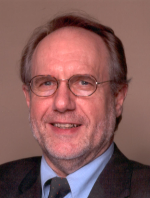Armin B. Cremers
Armin B. Cremers | |
|---|---|
 | |
| Born | June 7, 1946 Eisenach, Germany |
| Alma mater | University of Karlsruhe |
| Scientific career | |
| Doctoral students | |
| Website | www |
Armin Bernd Cremers (born June 7, 1946) is a German mathematician and computer scientist. He is a professor in the computer science institute at the University of Bonn, Germany. He is most notable for his contributions to several fields of discrete mathematics including formal languages and automata theory. In more recent years he has been recognized for his work in artificial intelligence, machine learning and robotics as well as in geoinformatics and deductive databases.
Life and work
[edit]Armin B. Cremers studied mathematics and physics at the University of Karlsruhe, Germany. After his graduate diploma (1971) and PhD (1972), both in mathematics, both summa cum laude, he received his academic lectureship qualification for computer science (1974), all from the University of Karlsruhe.[1] Following an invitation by Seymour Ginsburg, he joined the University of Southern California (USC), Los Angeles, in 1973 where he worked until 1976 as an assistant professor of electrical engineering and computer science. With Ginsburg he initiated Grammar Forms, a new formalism for grammatical families.[2][3]
In 1976 A. B. Cremers returned to Germany and was appointed to full professor of computer science at the University of Dortmund, where he remained until 1990, holding the chair for information systems.[4] During the same time he continued working as a visiting research professor at USC, where together with Thomas N. Hibbard he developed the concept of Data Spaces, a comprehensive computational model, in theory and applications.[5]
At the University of Dortmund A. B. Cremers served as chairman of the computer science department and, since early 1985, as vice president for Research and Junior Scientific Staff. In this position he was liaison for the development of the Technology Center Dortmund Archived 2021-05-09 at the Wayback Machine. He was the initiator and founding director of the Center for Expert Systems Dortmund (ZEDO) and the NRW State Research Collaborative in Artificial Intelligence (KI-NRW).[6][7] From 1988 to 1996 he was also a member of the supervisory board of the German National Research Center for Mathematics and Data Processing (GMD).
Since 1990 A. B. Cremers has been professor and director of computer science and head of the research group in artificial intelligence at the University of Bonn. From Bonn he has contributed fundamentally to artificial intelligence and robotics (with Wolfram Burgard, Dieter Fox, Sebastian Thrun among his students), and to the development of software engineering, particularly in civil engineering, and information systems, particularly in the geosciences.[8] The paper "The Interactive Museum Tour-Guide Robot"[9] won the AAAI Classic Paper award of 2016.[10] Together with Matthias Jarke A. B. Cremers established the Bonn-Aachen International Center for Information Technology [de] (B-IT) in 2001 and led this as Founding Scientific Director from the University of Bonn side[11] until his retirement from teaching in 2014.
From 2004 to 2008 Cremers was Dean of the School of Mathematics and Natural Sciences, and from April 2009 to July 2014 University Vice President for Planning and Finance. He is member of advisory boards, e.g.,[12][13] as well as Chairman of the University Council of the University of Koblenz-Landau.[14]
References
[edit]- ^ "Vita - Prof. Dr. Armin B. Cremers". Archived from the original on 18 May 2015. Retrieved 5 May 2015.
- ^ Cremers, Armin B.; Ginsburg, Seymour (1974), Loeckx, Jacques (ed.), "Context-Free Grammar Forms", Automata, Languages and Programming, 2nd Colloquium, University of Saarbrücken, July 29 - August 2, 1974, Proceedings, Lecture Notes in Computer Science, 14, Springer, ISBN 3-540-06841-4
- ^ Armin B. Cremers at DBLP Bibliography Server
- ^ "Vita - Prof. Dr. Armin B. Cremers". Archived from the original on 18 May 2015. Retrieved 5 May 2015.
- ^ Cremers, Armin B.; Hibbard, Thomas N. (September 1978). "Formal Modeling of Virtual Machines". IEEE Transactions on Software Engineering. SE-4 (5): 426–436. doi:10.1109/TSE.1978.233862. S2CID 17894202.
- ^ "Homepage KI-NRW". Research Cooperative KI-NRW - Knowledge-Based Software Technology in North Rhine-Westphalia. Retrieved 5 May 2015.[permanent dead link]
- ^ "Neue Wege der Verbundforschung in Künstlicher Intelligenz - Prof. Cremers Sprecher der Arbeitsgemeinschaft deutscher KI-Institute" (PDF). Bonner Universitätsnachrichten, Jg. 24, Nr. 184, November 1991.
- ^ Armin B. Cremers publications indexed by Google Scholar
- ^ Burgard, Wolfram; Cremers, Armin B.; Fox, Dieter; Hähnel, Dirk; Lakemeyer, Gerhard; Schulz, Dirk; Steiner, Walter; Thrun, Sebastian (1998). "The interactive museum tour-guide robot". Proceeding AAAI '98/IAAI '98 Proceedings of the Fifteenth National/Tenth Conference on Artificial Intelligence/Innovative Applications of Artificial Intelligence. AAAI '98/IAAI '98: 11–18. ISBN 9780262510981. Retrieved 21 March 2016.
- ^ "AAAI Classic Paper Award".
- ^ Bonn-Aachen International Center for Information Technology (B-IT). Retrieved on April 24, 2015.
- ^ Advisory Board Archived December 15, 2014, at the Wayback Machine. University of the Fraunhofer Institute for Intelligent Analysis and Information Systems (IAIS). Retrieved on April 26, 2015.
- ^ Advisory Board. Website of the German Reference Centre for Ethics in the Life Sciences (DRZE). Retrieved on April 26, 2015.
- ^ University Council Archived 2017-07-17 at the Wayback Machine. Website of the University of Koblenz-Landau. Retrieved on April 26, 2015.
External links
[edit]- Living people
- 1946 births
- German artificial intelligence researchers
- German computer scientists
- 20th-century German mathematicians
- Machine learning researchers
- German roboticists
- Academic staff of the University of Bonn
- Academic staff of the Technical University of Dortmund
- Karlsruhe Institute of Technology alumni
- People from Eisenach
- 21st-century German mathematicians
